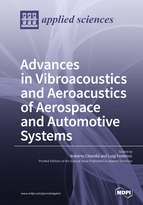Advances in Vibroacoustics and Aeroacustics of Aerospace and Automotive Systems
A special issue of Applied Sciences (ISSN 2076-3417). This special issue belongs to the section "Acoustics and Vibrations".
Deadline for manuscript submissions: closed (31 August 2017) | Viewed by 54494
Special Issue Editors
Interests: fracture mechanics; fatigue; bioengineering; vibroacoustics; boundary element method; finite element method; statistical energy analysis; dynamics
Special Issues, Collections and Topics in MDPI journals
Interests: vibroacoustics; aeroacoustics; aerospace systems; air traffic management (ATM)
Special Issues, Collections and Topics in MDPI journals
Special Issue Information
Dear Colleagues,
The journal of Applied Sciences is a forum for the communication of ideas and methods presently in use at the forefront of technology in the field of applied engineering. The purpose of this Special Issue is to highlight the latest advances in vibroacoustics and aeroacoustics applied to aerospace and automotive industries. Topics to be covered in this special issue include, but are not limited to, vibration and/or sound radiation of aerospace and automotive vehicles, aerodynamically generated noise, jet noise, instrumentation and data analysis in sound and vibration, passive and active noise control and vibroacoustic properties of materials. The Special Issue provides an opportunity for scientists and engineers to publish their studies of current interest, both in the theoretical and experimental fields of research, and also articles introducing new approaches and methodologies in the vibroacoustics and aeroacoustics fields.
Prof. Roberto Citarella
Dr. Luigi Federico
Guest Editors
Manuscript Submission Information
Manuscripts should be submitted online at www.mdpi.com by registering and logging in to this website. Once you are registered, click here to go to the submission form. Manuscripts can be submitted until the deadline. All submissions that pass pre-check are peer-reviewed. Accepted papers will be published continuously in the journal (as soon as accepted) and will be listed together on the special issue website. Research articles, review articles as well as short communications are invited. For planned papers, a title and short abstract (about 100 words) can be sent to the Editorial Office for announcement on this website.
Submitted manuscripts should not have been published previously, nor be under consideration for publication elsewhere (except conference proceedings papers). All manuscripts are thoroughly refereed through a single-blind peer-review process. A guide for authors and other relevant information for submission of manuscripts is available on the Instructions for Authors page. Applied Sciences is an international peer-reviewed open access semimonthly journal published by MDPI.
Please visit the Instructions for Authors page before submitting a manuscript. The Article Processing Charge (APC) for publication in this open access journal is 2400 CHF (Swiss Francs). Submitted papers should be well formatted and use good English. Authors may use MDPI's English editing service prior to publication or during author revisions.
Keywords
- Vibroacoustics
- Aeroacoustics
- Acoustics
- Noise
- Vibration
- Aerospace
- Automotive







